QNAP TS-451+ NAS Review
Why you can trust Tom's Hardware
SMB, iSCSI And Standard Server Workloads
Single-Client SMB Performance

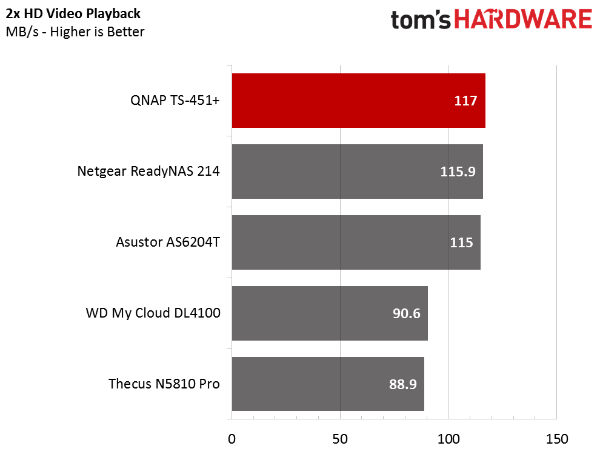
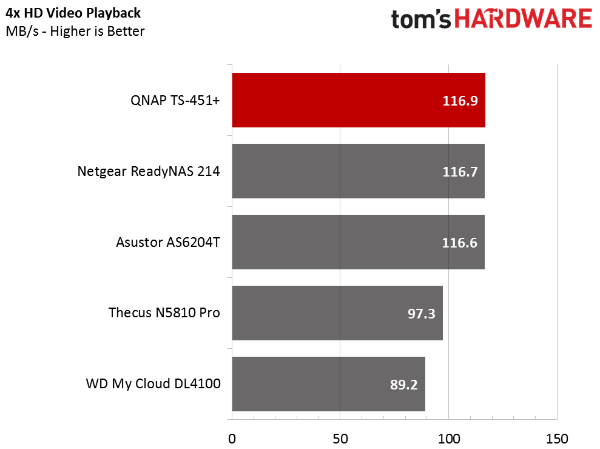









QNAP's TS-451+ performed well in the synthetic measurements, so it's not surprising to see it leading many of our real-world tests over SMB.
These benchmarks are traditional home and small business NAS metrics, where users transfer files to and from the system. For most folks, this is exactly why you buy networked storage.
Multi-Client SMB Performance


Each node in the multi-client test falls short of saturating our test subjects. We used real Microsoft Office software to record traces that run from each system with a dedicated gigabit Ethernet connection to the network. The combined workload does tax the GbE link. With some products, we hit other hardware limits before banging on Ethernet's ceiling.
We can see this happen on two of the charts; either throughput sharply decreases or the latency spikes. I like to use latency to determine the load level at which a NAS device still delivers acceptable performance. As you can imagine, it takes a lot of traffic to make a NAS fail outright. But you don't want the nasty user experience preceding that failure, either.
Single-Client iSCSI Workloads



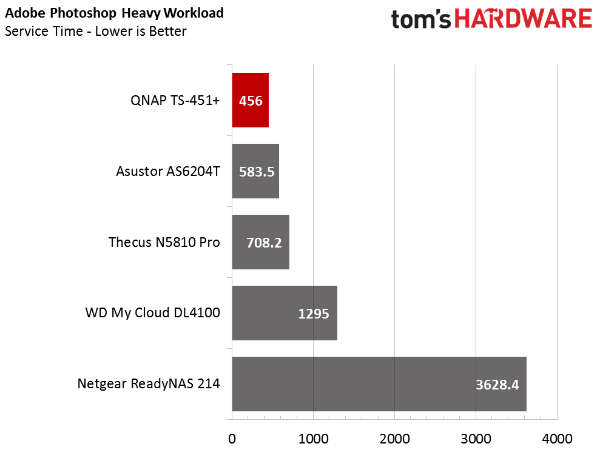


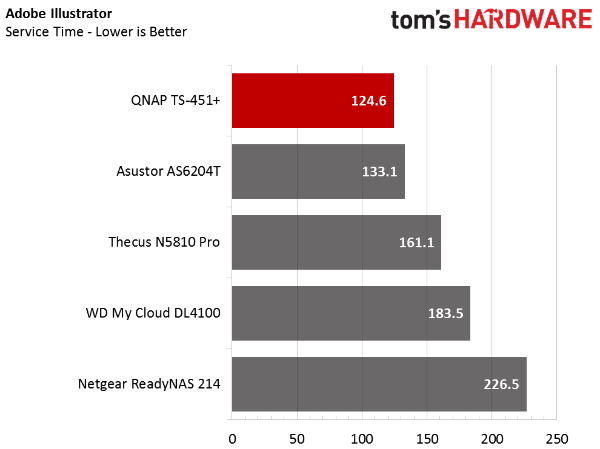


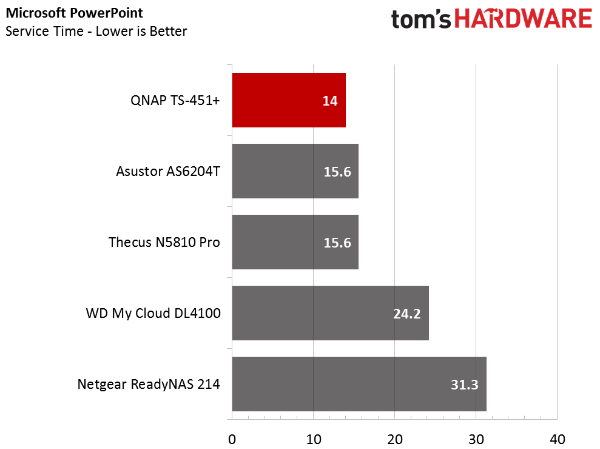
iSCSI is the most underused feature on NAS appliances today. All of our comparison products have the feature installed right out of the box, but we rarely hear about it being used. iSCSI adds a drive letter to the volume and shows up on your computer as a local disk. It's a great way to deal with large game libraries, particularly since the data on a RAID 5 array is redundant.
These results are presented in time units rather than throughput.
QNAP delivers strong iSCSI performance, giving its TS-451+ the advantage it needs to come out on top. The throughput result is about as fast as a 7200 RPM disk inside of your own desktop.
Get Tom's Hardware's best news and in-depth reviews, straight to your inbox.
Standard Workloads
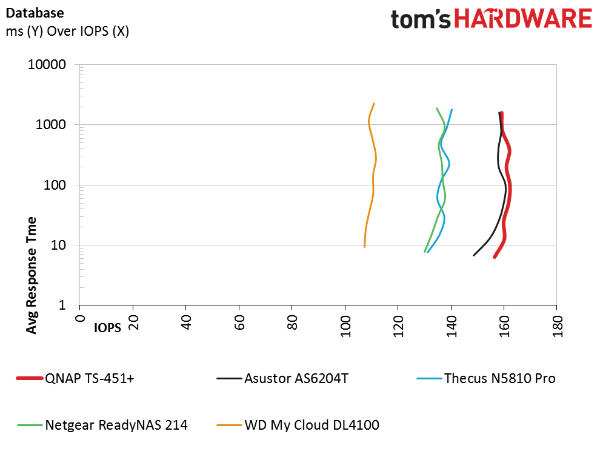
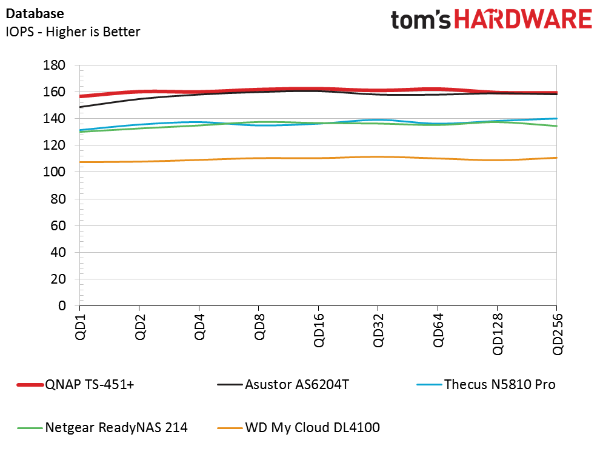








Since none of the systems scale as queue depths increase, the snake charts that show IOPS compared to latency are nearly vertical. Only a small number of users will deploy their low-cost storage appliances in one of these single-workload applications, though the systems are powerful enough.
Response time starts out around 8ms across the board. You never want to push much beyond 100ms of latency, and 200ms is a practical maximum.
Current page: SMB, iSCSI And Standard Server Workloads
Prev Page Four-Corner Performance Testing Next Page Conclusion
Chris Ramseyer was a senior contributing editor for Tom's Hardware. He tested and reviewed consumer storage.
-
RedJaron ReplyThis is the new breed of network-attached devices that extends beyond storage. Many new home and small office QNAP systems fall into this category. Nobody has coined an official term for these systems, but someone really should. Continuing to call them NAS fails to capture everything they're capable of.
Hmmm, well first, the problem is that NAS on its own was a bit of a misnomer in a lot of cases. The idea of "Network Attached Storage" is just talking about the storage itself, the drives, not the machine that actually hosts or manages them. It works fine for describing an external hard drive plugged into a router over USB, but any time you have a dedicated device for hosting and managing a storage array, the idea of NAS alone was no longer sufficient for it. Even if it didn't have the media abilities this one did, if it had its own OS, if you could remote into to and configure the storage system, if it was more or less autonomous, that's more a server than just NAS array.
NAS Server, or NASS is probably too similar and would be confusing. Network Attached Managed Storage or Networked Attached Hosted Storage would be more accurate, though "hosted" has cloud storage connotations so that may not be great. You could call them NARCs for network attached RAID controllers/computers. But in reality these things are servers. A Celeron is far beyond a simple hard drive or RAID controller and QNAP's OS is far beyond a simple router firmware. These are network storage servers, or simple network storage servers if you want to differentiate them from from the big, expensive server clusters. If you want to keep it close to NAS, I'd call it a NARS ( network attached RAID server ). -
blazorthon ReplyHmmm, well first, the problem is that NAS on its own was a bit of a misnomer in a lot of cases. The idea of "Network Attached Storage" is just talking about the storage itself, the drives, not the machine that actually hosts or manages them. It works fine for describing an external hard drive plugged into a router over USB, but any time you have a dedicated device for hosting and managing a storage array, the idea of NAS alone was no longer sufficient for it. Even if it didn't have the media abilities this one did, if it had its own OS, if you could remote into to and configure the storage system, if it was more or less autonomous, that's more a server than just NAS array.
NAS Server, or NASS is probably too similar and would be confusing. Network Attached Managed Storage or Networked Attached Hosted Storage would be more accurate, though "hosted" has cloud storage connotations so that may not be great. You could call them NARCs for network attached RAID controllers/computers. But in reality these things are servers. A Celeron is far beyond a simple hard drive or RAID controller and QNAP's OS is far beyond a simple router firmware. These are network storage servers, or simple network storage servers if you want to differentiate them from from the big, expensive server clusters. If you want to keep it close to NAS, I'd call it a NARS ( network attached RAID server ).
NARC has my vote. -
palladin9479 ReplyThis is the new breed of network-attached devices that extends beyond storage. Many new home and small office QNAP systems fall into this category. Nobody has coined an official term for these systems, but someone really should. Continuing to call them NAS fails to capture everything they're capable of.
We do have a name for it. It's a very old name with a distinguished history, it's known as "File Server". This is no different then having Unix / Linux / NT installed on a server and then exporting storage to a local network in whatever language / protocol is necessary. Hiding the OS from the customer nor automating the maintenance of the File Server does not change it's designation or purpose. Further if we wanted to install additional services onto our File Server it now becomes an Application Server and since it's an All-In-One device we could just call it a Server. Congratulations on reinventing a 1980's concept.
As for iSCSI in a home environment, just say no. There is a reason it's not used. Without jumbo frames, and a dedicated VLAN / QoS you are going to be shredding your network I/O. Each 4K I/O block gets broken into three separate Ethernet frames and blasted out across the switch where it competes with every other form of traffic for bandwidth and network I/O. It's heard by the distant end, reassembled in the network buffer, read and then another request is sent out, all without compression or any form of traffic shaping. It's perfectly fine for lab and experimental work but absolutely atrocious for real world work loads. If you have to store and execute data remotely then use SMB via a mounted drive letter or even a NTFS junction via mklink.
mklink /d C:\FolderToInstallStuff \\NASServer\\SMBShareFolder
Will create an entry in the NTFS file table that looks like a folder to everything, except the file storage subsystem, any file operations directed to that folder will instead be redirected to the remote SMB server. Applications will act exactly the same but without having to deal with the issues of having to abstract a block level device over a home network connection. Let the OS do it's job with optimizing network file I/O.
Side note about performance. The real difference between file level and block level access is where the onus of file system management takes place. With file level the remote file server is responsible and must spend CPU cycles and memory for caching the data, on block level your local machine is responsible for doing it. Since local machines tend to have more CPU / memory iSCSI would win in a back-to-back configuration (Client <-> Server) with nothing else happening on the switch, in which case might as well use a cross-over cable. The moment you start placing additional traffic on the network that the iSCSI packets now need to compete with, this starts to change as iSCSI wasn't designed to fight with other traffic nor is the client computer even aware that it has to. Also once your iSCSI storage manager has enough CPU power and memory to effectively manage it's own file shares, that advantage of iSCSI melts away and the performance swings in the other direction, especially as file services are available to all incoming clients while iSCSI is only available to the initiator.
Since these QNAP devices have decently powerful x86 CPU's with generous amounts of memory host side resource contention won't be a problem. It's having to shove 4K random I/O requests over a 1500MTU pipe on a general purpose VLAN with all the other traffic that's the problem. The real solution is local storage for data intensive programs and remote storage for shared media files. SATA storage is cheap, no need to reinvent the wheel in the home. -
fraserw Stupid question: Can this box support local mount through usb3 while still allowing the drive to be network mounted to other machines?Reply -
VVV850 You mention HDMI port but never test what you can do with it. How able is the NAS as a media player or as a VM Player. You only approach the same old statistics of a file server even though you mention that it is a lot more then that...Reply -
CRamseyer ReplyStupid question: Can this box support local mount through usb3 while still allowing the drive to be network mounted to other machines?
No, this system doesn't have any direct attach function outside of Ethernet. -
heffeque ReplyYou mention HDMI port but never test what you can do with it. How able is the NAS as a media player or as a VM Player. You only approach the same old statistics of a file server even though you mention that it is a lot more then that...
My thoughts exactly!Also, QNAP has a very VERY good OS. Many Synology purists would be surprised with how good QNAP has gotten. -
CRamseyer I think QNAP has the best on the market right now. Admittedly I haven't spent a lot of time with Thecus' new OS 7 but I plan to this weekend.Reply
I'll also have time to move the racks over to a dedicated server closet. On the way I can shoot some images for the upcoming How We Test NAS article. -
ttocsmij ReplyThis is the new breed of network-attached devices that extends beyond storage. Many new home and small office QNAP systems fall into this category. Nobody has coined an official term for these systems, but someone really should. Continuing to call them NAS fails to capture everything they're capable of.
We do have a name for it. It's a very old name with a distinguished history, it's known as "File Server". This is no different then having Unix / Linux / NT installed on a server and then exporting storage to a local network in whatever language / protocol is necessary. Hiding the OS from the customer nor automating the maintenance of the File Server does not change it's designation or purpose. Further if we wanted to install additional services onto our File Server it now becomes an Application Server and since it's an All-In-One device we could just call it a Server. Congratulations on reinventing a 1980's concept.
As for iSCSI in a home environment, just say no. There is a reason it's not used. ...
... especially as file services are available to all incoming clients while iSCSI is only available to the initiator.
Since these QNAP devices have decently powerful x86 CPU's with generous amounts of memory host side resource contention won't be a problem. It's having to shove 4K random I/O requests over a 1500MTU pipe on a general purpose VLAN with all the other traffic that's the problem. The real solution is local storage for data intensive programs and remote storage for shared media files. SATA storage is cheap, no need to reinvent the wheel in the home.
I'm not sure what palladin9479 is trying to say here. Is he against QNAP, NAS for home, or what, exactly?!
I need a place to backup the three computers (wireless, wireless, wired) we use here at the house and this sounds like the ticket. Am I wrong? Should I be looking at something different? I was just thinking I could connect an NAS to an Ethernet port on the wireless router and start setting things up.
-
CRamseyer You will be fine with a QNAP system attached to your existing network. Palladin9479 was referring to iSCSI used in the home.Reply
iSCSI is just a way of adding storage one or more of your computers. It has some advantages over SMB shares. When attached (through software) to your computer the share shows up as a drive letter and the system sees the share as local storage.
You can do the same thing with a network share by mapping a share as a drive letter but not all software sees the network mapped drive as local storage. If you plan to install programs on the NAS rather than your C: drive the network mapped drive can be a problem. With iSCSI the connection is always there. Mapped drives don't offer the same same reliability or security as iSCSI.
